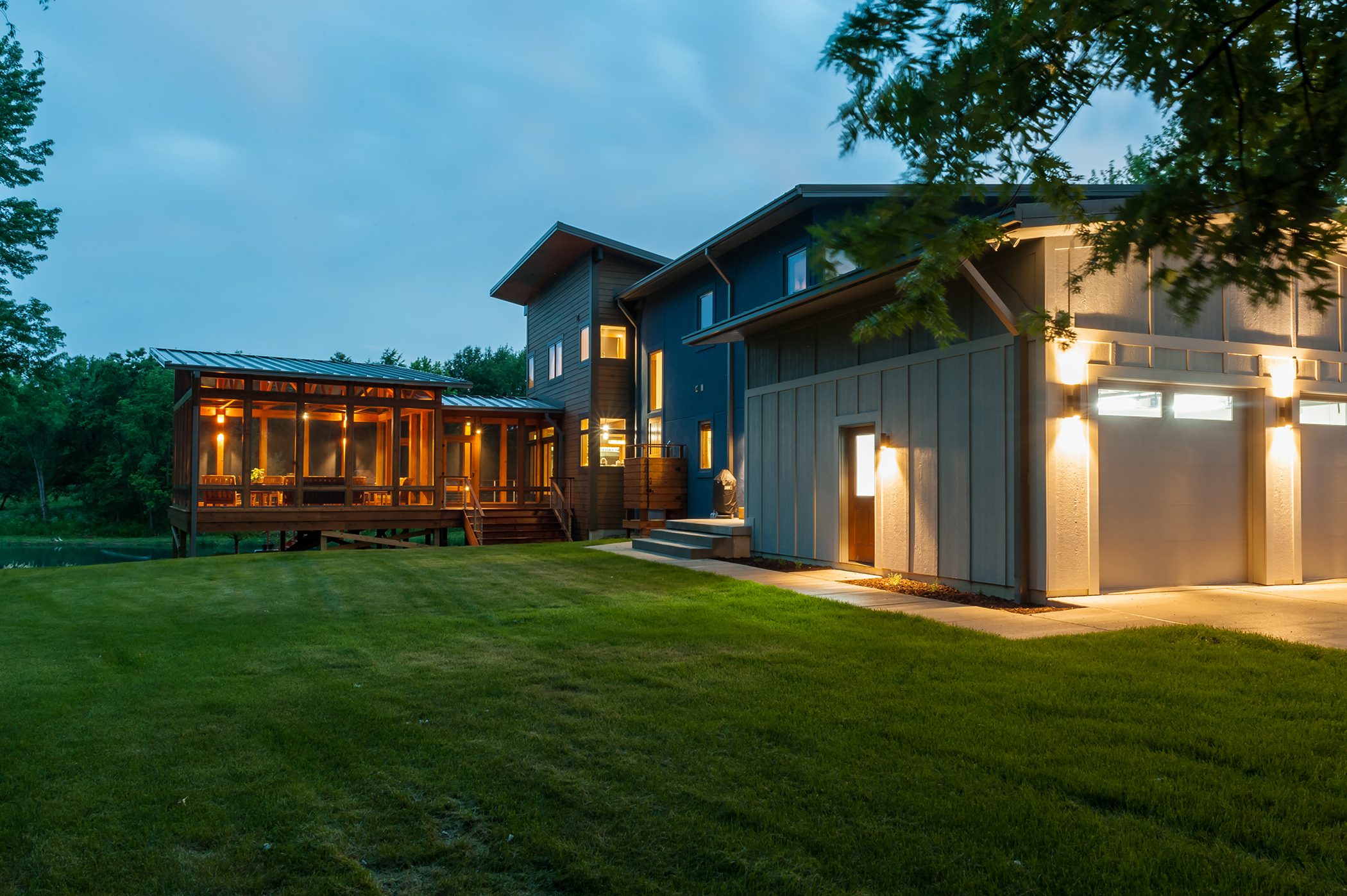I recently wrote an article for Houzz.com on how to make the outside of your home welcoming at night. It had been awhile since my article on downlights drew so many sharply divided comments, so I had grown complacent and used to the vanilla “great article” responses.
Whoops.
While many readers appreciated the article and the info graphic became my most saved image, there was also a strong thread of negative comments centered around environmental responsibility. Excess light at night disrupts migrating birds, leads to the death of newborn turtles trying to find the sea, changes the feeding grounds of nocturnal animals, and sends energy into space. Wasted light requires wasted electricity which requires wasted power generation which causes further environmental degradation. All that light also makes it hard to see they sky itself, and the majority of Americans cannot see stars at night. On top of the harm to the planet, too much light at night disrupts our own circadian rhythm and we suffer a host of maladies as a result. Light is bad stuff.
On the flip side, light is good stuff. We know that a carefully illuminated home can be welcoming and inviting to our guests and foster a sense of security. We know lighting can extend our enjoyment of patios and decks past sunset and support pool parties deep into the night. I have a stepping stone path between the house and my studio, with path lights making it easier for me to navigate in the wee hours of the morning or in the evening in December.
I’m not quite ready to give up all of my electric light. Not yet. But I care about the planet and want to see the stars. So what can we do? Here are proposed rules for balancing our human needs and the planet’s environmental health.
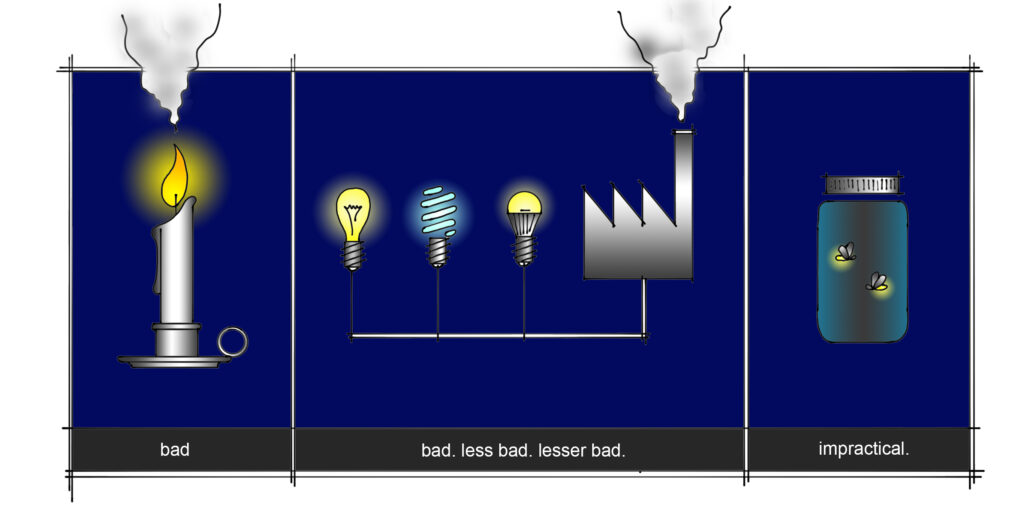
Rule #1: Beware of Greenwashing
It’s tempting for manufacturers and retailers to claim that LED lighting is “good for the environment.” In reality LED lighting is bad for the environment. LEDs use electricity, require the manufacture of chips and circuits and fixtures and heat sinks, can cause light pollution and circadian disruption. We have to mine the earth for materials, smelt metals in foundries, and assemble units in factories. We ship them across the globe, drive them in diesel trucks, and deliver them via airplane.
A more truthful statement would read: “LED lighting is not as bad for the environment as some other sources.” So that begs the question- what lighting isgood for the environment?
None.
From the dawn of the human era, we have used light at a cost. Whether it is cutting down trees, starting a campfire, and sending carbon into the atmosphere or hunting whales to the brink of extinction for our oil lamps, the light we can control is bad for the planet. In recent years we switched from incandescent to compact fluorescent to LED, but all those sources draw energy from the same electric grid. If we’re powered by coal or natural gas or nuclear power, there is a cost. Even wind power requires the construction of turbines and transmission lines.
Now, with LEDs, we have the potential to put light in places previously inaccessible. We can put lights in our flower vases to make the water glow. We can put light in our purses so we can find our keys. We can put lights on our keychains, in our cupholders, in our cell phones, and stick them on our closet shelves. We’re putting light everywhere- and I’m no saint. My portfolio is full of light in unexpected places. If I replace one incandescent bulb with and LED, but then add LEDs in five more places, have we gained anything at all?
What’s the takeaway? It’s all bad for the environment, so use the most energy-efficient source you can. Right now that’s typically LED, but who knows what is coming down the road. And then consider Rules 2-4.
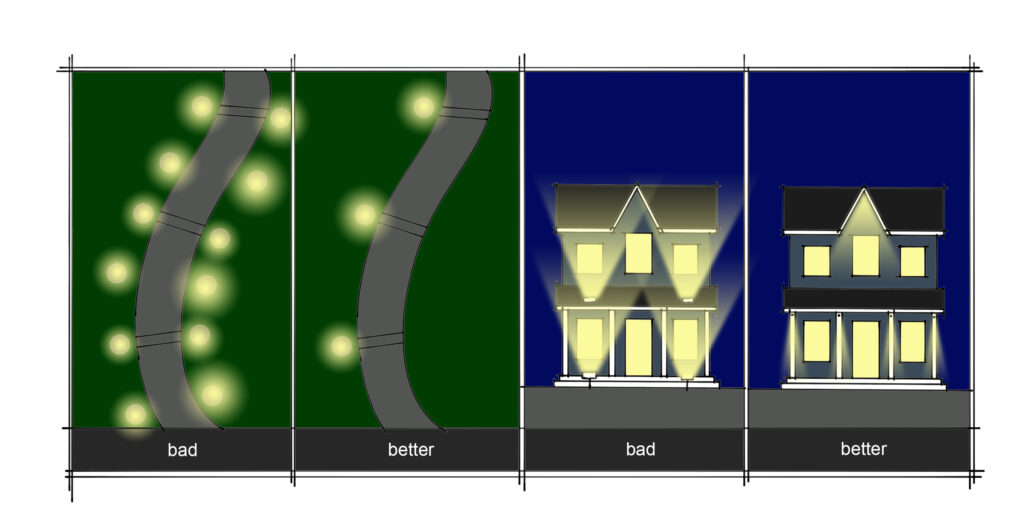
Rule #2: Enjoy the Dark- Use Less Light
Darkness is not inherently bad. In fact, our bodies and minds depend on darkness to rest and rejuvenate. Darkness helps us relax, calm down, settle in. Darkness can set the mood for a holiday party or a romantic dinner. Yet for some reason many of us try to banish it completely at night. We light the street, we light the driveway, we light the sidewalk, we light the porch, we light the trees, we light the bushes, we light the flowers…you get the idea.
Ever heard the saying “there’s a light at the end of the tunnel?” It means we can see the end of a hard stretch and it’s going to be good. But it comes from a very real experience: if we can see the light ahead of us, we feel comfortable even when we are still in the dark.
Apply that to your home. Leave the driveway darker and count on your headlights doing some work. Create dark spaces between your path lights; you’ll still be able to navigate safely so long as any steps are illuminated. Avoid floodlighting your home and pick out a few key details to light instead. The result is usually much more interesting, more comfortable, and has the added benefit of using less electricity and being better for the environment than the alternative.
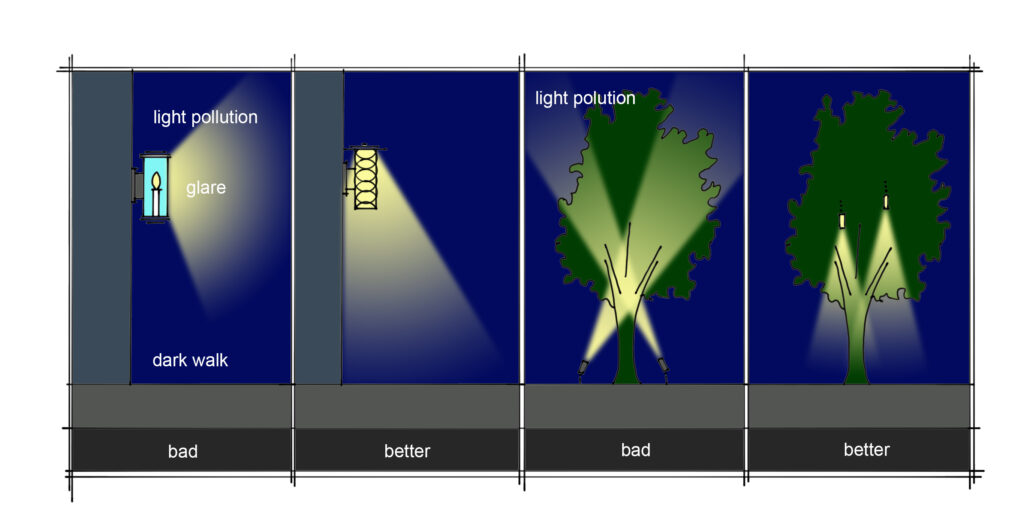
Rule #3: Point it Down- Don’t Light the Clouds
Go outside and look at your light fixtures. If you can see a light bulb, you’re wasting light. If it is going into your eyes, then it is not lighting the sidewalk or the home. When you’re not standing there, that light will go out into the yard, into the neighborhood, up to the sky, and into space.
If you can see the light bulb, your fixtures need replaced.
You’re also at risk of causing glare and making it harder to see when your iris closes down. A bare light bulb will be the brightest spot in your view, and everything else will be darker by contrast. That’s not good design.
Exterior light sources should point down and have shielded bulbs so that glare is minimized and impact is maximized. Point wall sconces down. Hang lights in trees instead of uplighting them, and you’ll have a beautiful and unique look all year without blasting the sky.
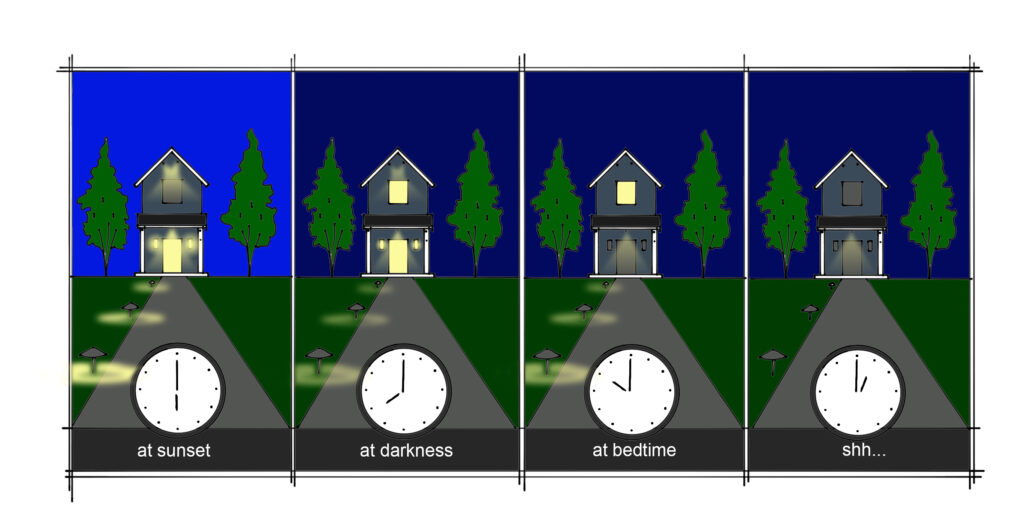
Rule #4: Turn it Down- and then Turn it Off
If I were in charge, I would change the electric and energy codes to require every light to be on a dimmer. Then I would promote “National Dimmer Day,” where everyone gets the night off to lower their dimmers. You could dim your dining room, but you could also dim your path lights. You could dim the lights in your kitchen and dim the lights on your porch. Dim them down until the atmosphere is just right, and in doing so your home will be more comfortable, use less energy, and cause less light pollution.
And don’t leave it on all night. Timers are cheap, motion sensors are easy to add, and smart switches make setting schedules easier than ever. At my house, there is absolutely no reason to light the path at 2:00am. I can’t stay up that late anymore, and my kids had better not be outside. Most of my lighting is set to come on at dusk, so the house welcomes us and guests, and the lights turn off around 9:30pm when I fall asleep and face-plant into my National Geographic or latest self-help book. If I get the chance to build a smarter home, my lighting won’t turn on when we’re away for most of the evening but will sense when we’re on our way home and snap to attention. We’ll use even less energy, our bulbs will last longer, and I’ll get to feel self-righteous again even if I’m not commuting by bicycle.
If you’re still with me, you’ll notice something. Every time we do something that’s better for the planet, like leaving dark spots, pointing it down, or dimming it, we get a better design, too. It’s a win/win. Or at least a win/not-as-bad.
Just remember- lighting is bad, so use less, point it down, and use dimmers. Your planet will thank you, your wallet will thank you, and your home will be more comfortable.
